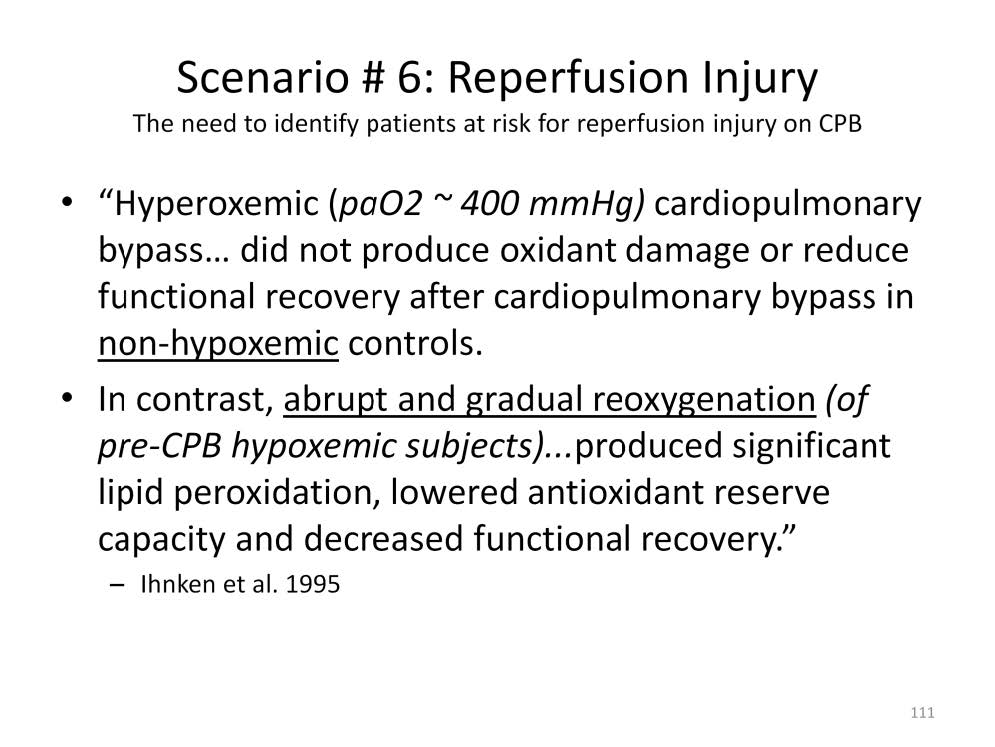
Ihnken K, Morita K, Buckberg GD, Young HH. Studies of hypoxemic/reoxygenation injury with aortic clamping: XI. Cardiac advantages of normoxemic versus hyperoxemic management during cardiopulmonary bypass. J Thorac Cardiovasc Surg 1995;110:1255-64.
“The conventional way to start cardiopulmonary bypass is to prime the cardiopulmonary bypass circuit with hyperoxemic blood (oxygen tension about 400 mm Hg) and deliver cardioplegic solutions at similar oxygen tension levels. This study tests the hypothesis that an initial normoxemic oxygen tension strategy to decrease the oxygen tension-dependent rate of oxygen free radical production will, in concert with normoxemic blood cardioplegia, limit reoxygenation damage and make subsequent hyperoxemia (oxygen tension about 400 mm Hg) safer. Thirty-five immature (3 to 5 kg, 2 to 3 week old) piglets underwent 60 minutes of cardiopulmonary bypass. Eleven control studies at conventional hyperoxemic oxygen tension (about 400 mm Hg) included six piglets that also underwent 30 minutes of blood cardioplegic arrest. Of 25 studies in which piglets were subjected to up to 120 minutes of ventilator hypoxemia (reducing fraction of inspired oxygen to 5% to 7%; oxygen tension about 25 mm Hg), 11 underwent either abrupt (oxygen tension about 400 mm Hg, n = 6) or gradual (increasing oxygen tension from 100 to 400 mm Hg over a 1-hour period, n = 5) reoxygenation without blood cardioplegia. Fourteen others underwent 30 minutes of blood cardioplegic arrest during cardiopulmonary bypass. Of these, nine were reoxygenated at oxygen tension about 400 mm Hg, and five others underwent normoxemic cardiopulmonary bypass and blood cardioplegia (oxygen tension about 100 mm Hg) with systemic oxygen tension raised to 400 mm Hg after aortic unclamping. Measurements of lipid peroxidation (conjugated dienes and antioxidant reserve capacity) and contractile function (pressure-volume loops, conductance catheter, end-systolic elastance) were made before and during hypoxemia and 30 minutes after reoxygenation. Hyperoxemic cardiopulmonary bypass did not produce oxidant damage or reduce functional recovery after cardiopulmonary bypass in nonhypoxemic controls. In contrast, abrupt and gradual reoxygenation without blood cardioplegia produced significant lipid peroxidation (84% increase in conjungated dienes), lowered antioxidant reserve capacity 68% +/- 5%, 44% +/- 8%, respectively, and decreased functional recovery 75% +/- 6% (p < 0.05), 66% +/- 4% (p < 0.05). Similar impairment followed abrupt reoxygenation before blood cardioplegic myocardial management, because conjungated diene production increased 13-fold, antioxidant reserve capacity fell 40%, and contractility recovered only 21% +/- 2% (p < 0.05). Conversely, normoxemic induction of cardiopulmonary bypass and blood cardioplegic myocardial management reduced conjungated diene production 73%, avoided impairment of antioxidant reserve capacity, and resulted in 58% +/- 11% recovery of contractile function.”

Perfusion Theory is an educational platform for the Oxygen Pressure Field Theory (OPFT). August Krogh’s theoretical concept of the oxygen pressure field is explained and then applied to clinical applications in perfusion practice.